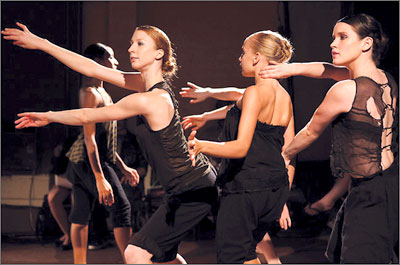Drafting the audience into very active service
Roslyn Sulcas
Audience participation. Is there a more unpleasant conjoining of
nouns in the English language?
Yet choreographers persist. Lauri Stallings's 'Halo,' presented by
her unpronounceable company, gloATL at the DMAC-Duo Multicultural Arts
Center in the East Village, involved a good amount of obligatory
audience involvement. The dancers came up close to the single row of
chairs along the walls of the theater and stared into our eyes.
They inserted fingers under our knees and lifted our legs. They sat
next to us, arms draped around our tense shoulders. They marched a
chosen few across the room to sit elsewhere. (I attempted resistance
until it became clear that the piece was never going to end unless I
moved.)
|

Members of Lauri Stallings’s troupe at the DMAC-Duo
Multicultural Centre in the East Village. |
Finally they selected partners to dance with, first waltzing benignly
then leaving the hapless civilians dumbfounded as they broke into wild,
bent-legged, lashing-arm, thrashing-torso sequences. The piece ended
with the spotlight on one such couple, the female dancer gyrating, the
male spectator standing uncertainly.
This idea, and much else in 'Halo,' comes directly from the work of
the Israeli choreographer Ohad Naharin. In 'Decadance' and 'Kamuyot' he
has performers invite audience members to dance, and in the moving 'Mamootot'
they occasionally sit among the audience and, at one point, move slowly
round the room, taking hands and gazing into eyes.
The imitation isn't surprising since Stallings's movement style is
closely based on Naharin's Gaga method, and it is full of the
fascinating odd impulses, explosive balletic extensions, and spasmodic
lurches and tics that characterize his work. But Naharin is a dance
genius, a rare original in his rigorous ability to use this movement to
connect to and evoke the dancer's inner states of pleasure and pain,
ecstasy and madness.
'Halo' certainly wants to evoke these states as it moves through
sequence after sequence set to very different types of music (not all
credited in the program): Bizet's 'Carmen,' Nina Simone singing 'Wild Is
the Wind,' Glazunov's ballet music for 'Raymonda,' harsh techno pop, and
much, much more. But although the six black-clad women all compel
attention through their forceful performances, the out-of-body states
they try to convey through staring eyes and gently bobbing heads feel
mostly layered over the sharply delineated dancing rather than emerging
from it. It's the imitation of inner demons, not the demons themselves.
And similarly, the approaches to the audience are the simulation of
connectedness rather than actual involvement. In Naharin's works there
is a sense of gentle communion with the spectators that is both
empathetic and unaggressive. In 'Halo' the dancers perform the breaching
of a taboo - touching strangers, breaking the code of performance - with
forceful intent. For some of the audience members it may be provocative.
But it's no more than that, and frequently quite a lot less.
New York Times |



